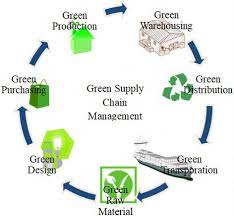Courtesy : www.trademo.com
Green supply chain
What is a Green Supply Chain and How to Create It?
It may help to first explain what we mean by a Green Supply Chain when we talk about creating one. It is the integration of eco-friendly methods into the conventional supply chain so as to minimize waste and carbon footprints and increase efficiency.
And a business can transform its traditional supply chain to a green one by including the “environment” factor in each and every stage of the supply chain – from product development to manufacturing to distribution to end customers. This can be done either via digital transformation or by simply creating relevant policies.
For instance, in the process of packaging materials, some of the packaging are done with containers made of plastic. Businesses should work on minimizing the use of plastic and switch to packaging made from sustainable materials.
This will help in the reduction of plastic as well as boost eco-friendly materials. Another way of turning your supply chain into a green and sustainable one could be to have a good return policy. You can refurbish and recycle the goods that have been returned which will also help waste reduction.
Benefits of Creating a Green Supply Chain
Apart from impacting the environment positively, a green supply chain has a lot of benefits for a business:
- Cost Reduction
Companies can save costs by implementing digital technologies that help in going green. IT Solutions that help in low consumption of power, substituting energy sources and recycling can create a positive impact on the financial sheets of a business.While implementing green initiatives, businesses focus on reducing the greenhouse gas emissions which in turn leads to making shorter trips and reducing shipments. This results in lowers costs as vehicles use less fuel and suffer minimized wear and tear.For instance, Nike changed the way it manufactured its new edition of shoes, reducing labor costs by up to 50% and reducing material usage by 20%, which resulted in 0.25% higher margins. - Sustainability of ResourcesIf a business has implemented green practices in its supply chain, there should be a process or policy in place in the supply chain that lets them be re-produce and recycle at the same pace at which their product is consumed.
- Being CompliantAccording to the second annual CDP Supply Chain Report that summarized climate change information from 710 suppliers, 6 percent of leading companies already deselect suppliers who fail to manage carbon.According to current projections, this number is set to rise to 56 percent in the future. Whether to comply with government regulations or meet the expectations of the customers or clients, businesses are finding motivation to go green.
- Digital Transformation helps in Reducing RiskYou must have heard stories about how a dangerous product slipped through the cracks and entered the supply chain. This is not just fatal for an employee but the company as a whole. When there are digital security solutions in place that ensure transparency, the chances of such incidents are very rare.Not only such solutions protect businesses from unethical partners, it also documents and tracks all the labor involved and goods from source to destination.Read here: How IoT is revolutionizing Supply Chain Networks
- Building Brand Reputation and Gaining Competitive AdvantageWith information readily available online these days, having a green supply chain will help you in building your brand reputation. Businesses that develop environment-friendly and technologically advanced products would be able to build and sustain their brand image.Customers want to buy from environmentally responsible businesses, and going green is an excellent way to let them know that your company has embraced the green revolution. According to a report, customers are willing to pay more for products that ensure green logistics practices and transparent supply chains.
Challenges of creating a green supply chain
Larger businesses around the world are trying to create green supply chains to help the planet and to help their businesses present themselves better. Unfortunately, green supply chains are very hard to deploy even for the most successful businesses in the world:
- Supplier compliance:The idea behind green supply chains rests on trust and good faith. To implement green supply chains, a company must procure its raw materials from other green supply chains. However, getting your suppliers to comply to your ideals is near impossible in most cases. Even first-tier suppliers often violate green supply chain requirements.Since most of your suppliers will originate in different countries, getting them to go along with your ideals will be difficult. One solution to this challenge is for every business, whether buyer or supplier should themselves try to be a part of the green supply chain wave.One way business can find out their second and third-tier suppliers is by studying global shipment data. Trademo Intel is a supply chain intelligence tool that helps you leverage global shipment data to improve your supply chains.TRY TRADEMO INTEL
- Lack of knowledge/ignorance:Global supply chains are massively complicated webs of buyers and sellers around the world. It is very difficult for companies to know about lower-tier suppliers and other companies that are involved in their supply chains. Most major companies only deal with first-tier suppliers for their business needs.This lack of knowledge and ignorance is why many companies get called out for unfair practices. An example would be the existence of Nike’s sweatshops in China. Despite a business’ best intentions, there’s only so much that can be done.




